Part 4: Jesus, the Kabbalah and the Gnostic wisdom
Discrepancies and contradictions
The many faces of Jesus
We decided to place several of the faces we found here and we have a related story as to the identity of the face on the Shroud of Turin page.
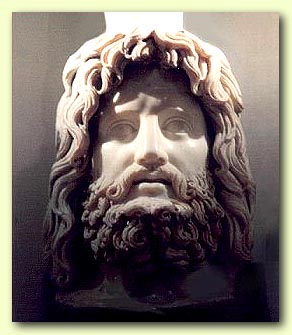 Serapis of Egypt, whose long-haired, bearded appearance
was adopted for the Christ character.
Serapis of Egypt, whose long-haired, bearded appearance
was adopted for the Christ character.
When Egypt fell under the rule of the Ptolemies, a new god
was created by Ptolemy I in an effort to unify Greeks and
Egyptians by establishing a deity that would be familiar to both
cultures. The new god was named Serapis, which combined
components of the Greek gods Zeus, Asklepios, and Dionysys as
well as the Egyptian deity Osiris and the sacred Apis bull cult.
Although the god had a Greek appearance, it also had some of
the features of an Apis bull as well as an Egyptian name.
Serapis was declared a god of fertility and the underworld,
but even though Egyptians tolerated this new deity, they never
truly accepted it. On the other hand, because Greek leadership
supported the new Serapis cult, many Greeks did accept and
follow it, but the artificially created cult never achieved its
goal of religious unity between Greeks and Egyptians.
Did this Greek God become the face of Jesus?
According to Numbers 7: 6 - 16, which confirms the priesthood duties and obligations. and... " For, lo, thou shalt conceive and bear a son, and no razor shall come on his head, for the child shall be a Nazarite unto God from the womb"... There is no where any real description of Jesus. His hair color, the shape of his face, nothing. But we have this from the Catholic encyclopedia
The image on the right below looks more like Jude than the others and it is stated in the Catholic encyclopedia that Jesus looked alot like his brother Jude.
JUDE THADDEUS
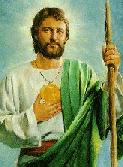 Profile;
Son of Cleophas, who died a martyr, and Mary.
Brother of Saint James the Lesser; nephew of Joseph; deceased.
Blood relative of Jesus Christ, and reported
to look a lot like him. As you can see Jude has short
black hair. So what did he really look like? And is the statue
above what was used for our long depicted image of Jesus?
.....Known as the keramion, this Stone is said to have borne the
face of Christ identical to that on the Shroud of Turin. We
can't find anything on this but in 2000 the Discovery Channel
aired a story that showed the face of Jesus as a rugged outdoors
type, with a strong bold face and short black hair.
Profile;
Son of Cleophas, who died a martyr, and Mary.
Brother of Saint James the Lesser; nephew of Joseph; deceased.
Blood relative of Jesus Christ, and reported
to look a lot like him. As you can see Jude has short
black hair. So what did he really look like? And is the statue
above what was used for our long depicted image of Jesus?
.....Known as the keramion, this Stone is said to have borne the
face of Christ identical to that on the Shroud of Turin. We
can't find anything on this but in 2000 the Discovery Channel
aired a story that showed the face of Jesus as a rugged outdoors
type, with a strong bold face and short black hair.
Not many of us believe this could be the face of a true 'savior' Other descriptions we found indicate that Jesus had features unlike anyone else in the area. These features were characteristic to the 'bloodline'.
Note: If you haven't read our 'death of the disciples series', You will probably dismiss the above theory. Cleophas was the brother of Joseph - Mary's husband. When Joseph died Cleophas was obligated to take care of Mary by marriage. We believe Jude, James, Simeon, and the two daughters and sisters of Jesus are from this marriage. The clues we found are all from the Catholic encyclopedia.
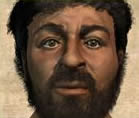
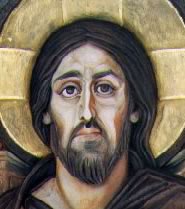 This computer-generated image (left) was produced for the
Discovery Channel's "Jesus: The Complete Story." It was created
to suggest what Jesus' face might have looked like, contrary to
the fair-skinned and fine-featured image familiar since medieval
times. The new image was created by a forensic artist at the
University of Manchester using the 2,000-year-old skull of a
Jewish man from Israel. Cues on hair and skin tone were taken
from frescoes of Jewish faces painted in the third century.
The result is a dark-skinned, curly-haired man with a round,
robust face and a stout nose. We feel this is incorrect.
This computer-generated image (left) was produced for the
Discovery Channel's "Jesus: The Complete Story." It was created
to suggest what Jesus' face might have looked like, contrary to
the fair-skinned and fine-featured image familiar since medieval
times. The new image was created by a forensic artist at the
University of Manchester using the 2,000-year-old skull of a
Jewish man from Israel. Cues on hair and skin tone were taken
from frescoes of Jewish faces painted in the third century.
The result is a dark-skinned, curly-haired man with a round,
robust face and a stout nose. We feel this is incorrect.
The New Testament depiction of Jesus suggests that he was
largely a law-abiding and highly nationalistic Jew, and a man
with strong ethical concerns. Like many of Judaism's great rabbis
, he saw love of neighbor as religion's central demand. Josephus'
writings say otherwise.
Though many Christians are under the impression that he opposed
Judaism's emphasis on law, in actuality he criticized
anyone who advocated dropping it. He said,
"Do not imagine that I have come to abolish the Law [the Torah] or
the Prophets," he declared to his early disciples. I tell you
solemnly, till heaven and earth disappear, not one dot, not one
little stroke, shall disappear from the Law until its purpose
is achieved." The law's "purpose," of course, is the universal
recognition of God, a goal which neither Christianity nor
Judaism believes was realized in Jesus' time, or since.
Jesus concluded his message with a severe warning: "Therefore,
the man who infringes even the least of these commandments and
teaches others to do the same will be considered the least in
the kingdom of heaven." (Matthew 5:17-19).
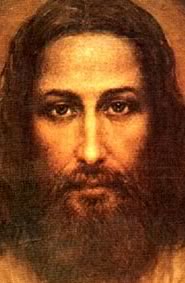 This image was created with a little help directly from the shroud.
This image was created with a little help directly from the shroud.
Ancient Religions - The messianic concept
The sacred books that make up the anthology modern scholars call
the Hebrew Bible - and Christians call the Old Testament -
developed over roughly a millennium; the oldest texts appear to
come from the eleventh or tenth centuries BCE. War songs such
as Exodus 15 and Judges 5 are very archaic Hebrew and celebrate
Israelite victories from the time preceding the Israelite
monarchy under David and Solomon. However, most of the other
biblical texts are somewhat later. And they are edited works,
collections of various sources intricately and artistically
woven together
The Origins of the Hebrew Bible and Its Components
Olam Ha-Ba: The Messianic Age
The world after the messiah comes is often referred to in Jewish literature as Olam Ha-Ba (oh-LAHM hah-BAH), the World to Come. This term can cause some confusion, because it is also used to refer to a spiritual afterlife. In English, we commonly use the term "messianic age" to refer specifically to the time of the messiah.
Belief in the eventual coming of the moshiach is a basic and fundamental part of traditional Judaism. It is part of Rambam's 13 Principles of Faith, the minimum requirements of Jewish belief. In the Shemoneh Esrei prayer, recited three times daily, we pray for all of the elements of the coming of the moshiach: in gathering of the exiles; restoration of the religious courts of justice; an end of wickedness, sin and heresy; reward to the righteous; rebuilding of Jerusalem; restoration of the line of King David; and restoration of Temple service.
Modern scholars suggest that the messianic concept was introduced later in the history of Judaism, during the age of the prophets. They note that the messianic concept is not mentioned anywhere in the Torah (the first five books of the Bible)....but it is in Enoch's Books.
However, traditional Judaism maintains that the messianic idea has always been a part of Judaism. The moshiach is not mentioned explicitly in the Torah, because the Torah was written in terms that all people could understand, and the abstract concept of a distant, spiritual, future reward was beyond the comprehension of some people. However, the Torah contains several references to "the End of Days" (achareet ha-yameem), which is the time of the moshiach; thus, the concept of moshiach was known in the most ancient times.
The anointment was not part of a 'death' ritual.
A Star Fire recipient King was considered to have become qualified for Kingship when he reached a pre-destined state of enlightened consciousness - a state when his aptitudes for wisdom and leadership had been enhanced to a realm of Kingship called the Malkû. It was from this Mesopotamian word Malkû that the Hebrews derived their words Malchus (King) and Malkhut (Kingdom).
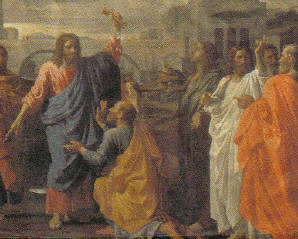 "As Above So Below" slides into our 'Lord's Prayer'
... (on Earth as it is in Heaven). In this detail, note the twins. One is in
white pointing up whilst the other, in blue and red, points down. One holds a Golden Key.
So we have two figures and 2 sets of mirrors (up/down is one, and twins/mirrors is the other).
from our friend at Mirrows
"As Above So Below" slides into our 'Lord's Prayer'
... (on Earth as it is in Heaven). In this detail, note the twins. One is in
white pointing up whilst the other, in blue and red, points down. One holds a Golden Key.
So we have two figures and 2 sets of mirrors (up/down is one, and twins/mirrors is the other).
from our friend at Mirrows
It is of interest to note how it was that the Christian Church eventually demolished the true significance of the Star Fire ritual by manoeuvring it into the realm of sinister Gothic legend. In the old tradition, the ultimate holders of the Malkhut were known as Dragons or Pendragons, and the reigning head was always known as Draco.
The term "moshiach" literally means "the anointed one," and refers to the ancient practice of anointing kings with oil when they took the throne. The moshiach is the one who will be anointed as king in the End of Days. The oil was very special and used only by the Essenes. It was very expensive and came directly from a plant grown only in India. We find that the anointer is Mary Magdalene. Mark 14:8.
The Spikenard cost as much as a year's wages and a so-called 'street walker' could not have afforded such a luxury. The fact that Mary openly lived with her brother Lazarus and her sister Martha excludes her from being a 'madam' of a brothel. Mary was called a harmartolos a term that meant she did not adhere to Jewish law. The term derived from the word 'archer' which means to 'miss the target' and is the root word for 'sinner' concocted by the Catholics. Anotherwords Mary was never a sinner and this word was put on her by the Catholic fathers to discredit her. Mary was not Jewish and this explains the hatred of Peter and the disciples towards her described in the Gospel of Thomas
The custom of the anointment was that only the wife of the sacred King is allowed to do this as this is the uniting factor between them in a sacred marriage. It is a ritual but not for the purpose of an actual burial as the gospel reports. It was a symbolic burial in which a priest would 'resurrect' the condemned one, or one who broke the religous law. This was never meant to be referred to as a permanent or literal death.
The Old Testament in the Song of
Songs 1:2, gives clues to the meaning of the anointment: where the
'Beloved' says; "While the King sitteth at his table,
my spikenard sendth forth the smell thereof' A bundle of
myrrh is my well-beloved unto me: he shall lie all night betwixt
my breasts".
So the 'anointing' of Jesus was a pagan ritual:
the woman who preformed it - Mary of Bethany - was a priestess.
We discuss her role on
The Lady of Jesus
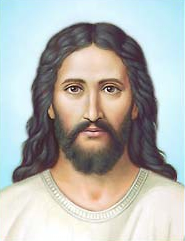 In the traditional sacred marriage, it was the bride of the
sacred king - the High Priestess - who chose the moment of his
symbolical death, who attended his burial and whose magic brought him out
of the underworld to new life. In most cases of course, this
'resurrection' was purely symbolic, being seen in the new life
of springtime - or, in the case of Osiris, in the annual
flooding of the Nile valley that would renew the fertility of
the land. 'Resurrection' means 'renewal', awakening. It does not
refer to an ascension to heaven as christians proclaim.
In the traditional sacred marriage, it was the bride of the
sacred king - the High Priestess - who chose the moment of his
symbolical death, who attended his burial and whose magic brought him out
of the underworld to new life. In most cases of course, this
'resurrection' was purely symbolic, being seen in the new life
of springtime - or, in the case of Osiris, in the annual
flooding of the Nile valley that would renew the fertility of
the land. 'Resurrection' means 'renewal', awakening. It does not
refer to an ascension to heaven as christians proclaim.
Men could not be 'Kings' with out the Queen or high priestess. The religion called for a union of the two to create a 'Oneness'. The king would not be acknowledged or gain full devine power without the authority of the priestess. With this union, the priestess gave her husband power and wisdom unequaled in ancient times. The marriage was deemed sacred and it took this union for the kings to actually become God's.
The sacred anointing was associated
with the marriage or union. With the union, the ultimate
blessing of regeneration was bestowed on the king who then
embodied the God. Anotherwords, this so-called pagan custom
was continued due to the Laws of Moses and the teachings
of Enoch, which were not ignored by the Essenes.
This custom began in Egypt.
The secret 'Books of Enoch' are
associated with the
Ark of the Covenant
and several copies of
them were found at Qumran and in Ethopia.
There are unavoidable associations with the ancient rites in which the priestess, who represents the goddess, was physically prepared to 'receive' the man who had been chosen to symbolize the sacred king or savior god. All the mystery schools of Osiris, Tammuz, Dionysus, Attis and so on included a rite - enacted by their human stand-ins-in which the god was anointed by the goddess prior to his actual or symbolic death, which would make the land fertle again. Traditionally it was three days afterwards that thanks to the magical intervention of the priestess/goddess, he rose again and the nation could heave a sigh of relief until the next year. In the mystery plays the goddess is saying; "They have removed my Lord ( Husband ) and I do not know where to find him" - virtually the same words as those ascribed to Mary Magdalene in the garden.
Mary Magdalene's anointing was both the announcment
that the moment for Jesus' sacrifice had arrived, and as a
ritual setting apart the sacred king by virtue of her own
authority as priestess. This role is diametrically opposed
by the church and out of self preservation it was censored.
The council of Nicaea, rejected the many Gnostic Gospels
and voted to include only Matthew, Mark, Luke and John in the
New Testament. The power of Mary Magdalene and her followers
was too widespread for the patriarchy to cope with, so
they were rounded up and executed.
see
Death of the Disciples
We also find in the Jewish holy book, the Talmud, which does not refer to Jesus as a native of Galilea or as coming from Nazareth, but does state dogmatically that he came from Egypt. Moreover, and perhaps most tellingly, the Talmud states unequivocally that the reason for Jesus' arrest was a charge of sorcery, and that he was an initiate of Egyptian Magic. It wasn't really a miracle after all. It was knowledge. Read about healing herbs and the 'magic potion' Jesus used to heal the sick. Cannabis and the Christ
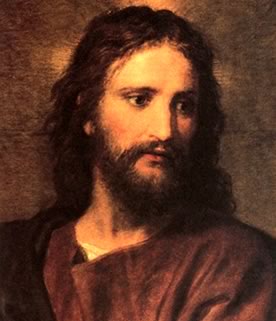 The New Testament in its present
form was composed and edited between 367-397 AD, about twelve
generations after the events in question. We also found
a reference that says; The term 'Son of God' has no Jewish precedent
and was not a concept associated with the Messiah - is itself
derived from the Graeco-Roman-Egyptian tradition. The
successful magician gained his abilities through allowing
himself to become the conduit for a god, as with tribal shamans.
So in effect, Jesus became the son of God as the result
of a so-called Magical possession by the deity. However
the Gnostic view is that any man who takes on the responsibility
of 'teaching' the gospel and the sacred rites and is dedicated
to this service, is also called 'A Son of God'. The depth of
this teaching is explained on
The Gnostic Teachings
The New Testament in its present
form was composed and edited between 367-397 AD, about twelve
generations after the events in question. We also found
a reference that says; The term 'Son of God' has no Jewish precedent
and was not a concept associated with the Messiah - is itself
derived from the Graeco-Roman-Egyptian tradition. The
successful magician gained his abilities through allowing
himself to become the conduit for a god, as with tribal shamans.
So in effect, Jesus became the son of God as the result
of a so-called Magical possession by the deity. However
the Gnostic view is that any man who takes on the responsibility
of 'teaching' the gospel and the sacred rites and is dedicated
to this service, is also called 'A Son of God'. The depth of
this teaching is explained on
The Gnostic Teachings
Contrary to the depiction given in the New Testament gospels of Matthew and Luke, Jesus was likely not born as the Messiah. He received this title through his initiation by John the Baptist, and so it is not surprising that both Mark and John are conspicuously absent of the virgin-birth mythology, and begin their stories of Jesus' short career with his initiation by John. But the Nag Hammidi states he taught the disciples for 11 more years after the resurrection.
Mark described the beginning of the gospel of Jesus:
"The beginning of the gospel of Jesus Christ, the Son of God;
(Mark 1:1 KJV) According to Mark, the beginning of the "good
news" about Jesus is not his virgin birth, his divine conception.
It is his baptism. In this baptism Jesus is declared the son of
God: "And there came a voice from heaven, saying, You are my
beloved Son, in whom I am well pleased." (Mark 1:11 KJV) This
is the beginning of the gospel of Jesus, according to Mark.
Although their version of Jesus' baptism by John describes it as involving submersion under water, the term "baptism" has connotations of "initiation", and Gnostic scriptures indicate that the original rite was performed in conjunction with the kaneh-bosm anointing rite, "the annointing taking place either before or after the baptismal ceremony." Some Gnostic texts also specifically state that Jesus recieved the title Christ "because of the anointing," not because of a water baptism. 'Christ' literally means, 'Anointed one'. John the Babtist was also called 'Christ' due to the anointment. This term was also used with King David and Solomon with their anointment as King.
Conceivably, the washing off of the oil with water would have been a means to begin the termination of ritual and the oil's effects.
The description of the after-effects of the rite clearly indicates that Jesus underwent an intense psychological experience, more than one would receive from a simple submersion in water.
The Oneness of the World
Olam Ha-Ba will be characterized by the peaceful co-existence of all people. (Isaiah 2:4) Hatred, intolerance and war will cease to exist. Some authorities suggest that the laws of nature will change, so that predatory beasts will no longer seek prey and agriculture will bring forth supernatural abundance (Isaiah 11:6-11:9). Others, however, say that these statements are merely an allegory for peace and prosperity.
All of the Jewish people will return from their exile among the nations to their home in Israel (Isaiah 11:11-12; Jeremiah 23:8; 30:3; Hosea 3:4-5). The law of the Jubilee will be reinstated.
In the Olam Ha-Ba, the whole world will recognize the Jewish G-d as the only true G-d, and the Jewish religion as the only true religion (Isaiah 2:3; 11:10; Micah 4:2-3; Zechariah 14:9). There will be no murder, robbery, competition or jealousy. There will be no sin (Zephaniah 3:13). Sacrifices will continue to be brought in the Temple, but these will be limited to thanksgiving offerings, because there will be no further need for expiatory offerings.
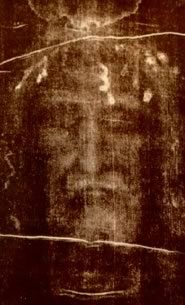 This is the actual shroud image. This is a much older man than
the revised images portray.
This is the actual shroud image. This is a much older man than
the revised images portray.
Jews do not believe that Jesus was the 'moshiach'. Assuming that he existed, and assuming that the Christian scriptures are accurate in describing him (both matters that are debatable), he simply did not fulfill the mission of the moshiach as Jews have always understood it and as it is described in scripture, cited above. They say Jesus did not do any of the things described above, and he did not bring about the anticipated messianic age. from.. Moshiach: The Messiah
We have seen on some web sites, the words of Jews who say Jesus
was a fake and a lier. Josephus susposedly did not believe in
Jesus as the messiah, but wrote many stories that are now considered fact
by Christian writers. There are 27 references to Jesus in Josephus's
writings. A couple of them, we believe actually do describe the real Jesus.
These references are on
The Real Jesus, the 'Other Story'
No body wants to acknowledge that the real Jesus was a 'freedom
fighter' and had a political as well as a religious agenda. If you read the
'Death'
series you found what the real agenda was. This agrees completely with Josephus's description of
Jesus and the other 'freedom fighters'. It also explains why the man called Jesus was also called
'The King of The Jews'.
How can anyone describe some of Josephus' work as fact and the rest trash? We find in his writings that Josephus did not believe Jesus was the Messiah, but that was thrown out because of Roman control and their deification of a man whose real name really wasn't Jesus at all..
The truth is Josephus' work was re-written, words deleted and rubbed out. Anything that was derogatory or unraveled the truth was 'cut' from the works by so-called Jewish and Christian ( Cannon ) writers. If Christian writers and editors had left Josephus' work intact, we would have a much clearer historical picture of the man he called Jesus. Yes, we do think Josephus knew him. We even think Josephus was related to him. His real name may have been Jacob ben Levi, 'son of the priest'.
What we have found is that the most sacred parts of the Jesus story have been 'copied' from other ancient religions beginning with the Osiris cult of Egypt. Like Christ, and like Adonis and Attis, Osiris and Dionysus also suffer and rise again. To become one of them is the mystical passion of their worshippers. They are all alike in that their mysteries give immortality. From Mithrasim, Christ takes the symbolic keys of heaven and assumes the function of the virgin-born Saoshayant, the destroyer of the evil one. In fundamentals, therefore, Christism is but a paganism reshaped. see Christ's Mission
The Christian myth grew by absorbing details from what they then called pagan cults. Because
like the image of the child-god in the cult of Dionysus, he was pictured in swaddling cloths in a basket
manger. He was born is a stable like Horus - the stable-temple of the Virgin goddess Isis, queen
of heaven. Again like Dionysus, he gave site to the blind; and like Attis and Adonis, he is mourned
by women. His resurrection took place, like that of Mithra, from a rock-tomb.
The Templar Revelation, Lynn Picket, Clive Prince
And this comparison; "According to Julius Marathus, a few
months before Augustus was born a sign was generally observed at
Rome, which gave warning that nature was pregnant with a King for the Roman people."
It's the same as; "Saying, Where is he that is born King of
the Jews? for we have seen his star in the east, and have come
to worship him." (Matthew 2:2 KJB)
The senate attempted to eliminate the future king by eliminating the male children born that
year: "Thereupon the Senate in consternation decreed that no male child born that year should be reared."
It's the same as; "Then Herod ... sent forth, and slew all the children that were in Bethlehem,
and in all the coasts thereof, from two years old and under, according to the time which he had
diligently enquired of the wise men." (Matthew 2:16 KJV) But didn't this happen when Moses was born
too? The 'Passover' was still celebrated at Easter by the true Hebrews, those who adheared to the
"laws of Moses".
We feel even though all these similarites exist there is something more to the story that makes it real and true. However what is necessary here is to seperate the real from the 'made up' so as to understand the real historical Jesus. If you have been to the Shepherd Kings page, or you read Enoch's secret books, you discovered there WOULD be a SAVIOR sent by God. This was predicted more than 10,000 years ago by the ancients. Christians are troubled by the Church's contradictory doctrines, which came about from the endeavor to blend incompatible Pagan and Jewish ideals. If they had left the original story intact we would discover that Jesus was incarnated as the Christ and taught the Egyptian mysteries to the real followers who were by then called Zealots. Some of these were Essenes and eventually they were called 'Gnostics'.
The Zealots were 'freedom fighters'.
What happened is the Church did everything in their power to destroy the ancient connections and gain control over the entire Christian movement beginning with a pagan cult of the 'Sun God'. Even the oval shown around the head of holy figures in most Christian paintings, came from the light or oval or as seen in an eclipse of the Sun God. Yahweh became the God of the Jews, but was this God a false God who still seems to rule today? see.. Passage, forward
According to Jewish writers, another Jew born about a century later came far closer to fulfilling the messianic ideal than Jesus did. His name was Simeon ben Kosiba, known as Bar Kochba (son of a star or son of god), and he was a charismatic, brilliant, but brutal warlord. Rabbi Akiba, one of the greatest scholars in Jewish history, believed that Bar Kochba was the moshiach. We discovered that Bar Kochba was actually the cousin of Jesus named King after Jesus's so-called death on the cross. Bar Kochba fought a war against the Roman Empire also, catching the Tenth Legion by surprise and retaking Jerusalem. He resumed sacrifices at the site of the Temple and made plans to rebuild the Temple. He established a provisional government and began to issue coins in its name. This is what the Jewish people were looking for in a moshiach; Jesus clearly does not fit into this mold. Ultimately, however, the Roman Empire crushed his revolt and killed Bar Kochba. But the cult he created moved all the way to the Iraq border and his followers became the followers of 'Mohammed' which is now Islam. The followers of Islam believed in Jesus for this reason, but they did not believe in the virgin birth, his divinity or the resurrection which explains their hatred of Christians.
Remnants describing the battle of Bar Kochba were hidden in the caves of Qumran. Now called 'The Dead Sea Scrolls'. After his death, all acknowledged that he was not the moshiach. Did they make a mistake about Jesus too? Will they make this same mistake again? They say the moshiach and the Olam Ha-Ba lay in the future, not in the past, but when the Devil promises to bring piece and rebuild the Temple, will they think he is the moshiach?
There are references in Revelations that say the Satan will sit in the Temple of God, until the moshiach literally throws him out in the street. Is that what's happening now, in our time? Is Satan sitting in the temple of our hearts with the liers? The Nag Hammidi Collection which was discovered in 1947, written under the name of the Great Seth, says, Moses was called a laughing stock as was Adam and Solomon. Were they fooled by the 'False God'. Who are the real liers and Devil worshipers?
Olam Ha-Ba: The Afterlife
Level: Basic
Traditional Judaism firmly believes that death is not the end of human
existence. However, because Judaism is primarily focused on life
here and now rather than on the afterlife, Judaism does not have much
dogma about the afterlife, and leaves a great deal of
room for personal opinion. It is possible for an Orthodox
Jew to believe that the souls of the righteous dead go to a place
similar to the Christian heaven,
or that they are reincarnated through many lifetimes,
or that they simply wait until the coming of the messiah,
when they will be resurrected. Likewise, Orthodox Jews can
believe that the souls of the wicked are tormented by demons
of their own creation, or that wicked souls are simply
destroyed at death, ceasing to exist.
Cayce; "the Essenes . . . were students of what ye would call astrology, numreology, phrenology, and those phases of study of the return of individuals - or reincarnation. These led to a proclaiming that a certain period was a cycle; and these had been the studies then of Aristotle, Enos, Mathesa, Judas, and those that were in the care or supervision of the school - as you would term in the present. These having been persecuted by those leaders, Sadducees (who taught) there was no resurrection - or there is no reincarnation, which is what resurrection meant in those periods."
For the first four hundred years after Jesus' birth, the term "Christian" was used to describe a wide variety of sects and a large volume of different documents. Through the acceptance of one of the more ascetic branches of Christianity by the Roman ruling class, Christianity eventually became the state religion of its former persecutors.
In an effort to unify the faith into a controllable mass, the newly formed Roman Catholic Church held a number of councils. These councils prohibited not only what they called pagans, but also differing Christian sects, and edited a wealth of Christian literature down to the few meager documents which have survived as the modern New Testament.
The King James Bible has references to 'the dead being
resurrected', but we feel these are the
Ascended 'Masters',
including Melchizedek, Jesus, John, Elijha, Enoch, Magnus, Krishna, Zarathustra,
and other 'Masters' such as the Gautama Buddah, from around the world, ect.
"Beloved Mighty I AM Presence and Holy Christ Selves of
Yogananda, Lao-Tzu, Lahiri Mahasaya, and all Ascended and
Unascended Saints, Masters and Adepts of God on Earth, the
Brotherhood of the Andes and the Priesthood of Melchizedek, the
Brothers and Sisters of the Golden Robe, the Diamond Heart, the
Blue Flame, the White Robe, and the Indigo Cape, all who Serve
in the Retreats of the Great White Brotherhood throughout the
Earth, Beloved Mighty I AM Presence and Holy Christ Selves of every
man, woman, and child throughout our entire Galactic System.
This is not a reference to your kinfolks or anyone known
presently in the material world.
'Resurrecting the dead' is an allegorical term
meaning "to raise the Living spirit into the world
of truth, and light which is a realization that there is 'Life
after real physical death'. The human body which is considered
'physical' is not connected to this life. And a physically 'dead'
human cannot be brought back to life as the NT claims
Lazerus was. Only 'initiates' participating in
the ancient rite, strictly an Essene Gnostic ritual, could be
'raised from the dead'... Jesus spent the night
'teaching' Lazerus the lessons that only initiates are allowed to know.
In Judaic type mysticism, taking the form of a search for God and an experience of divinity, esotericism is fundamentally based upon the law of correspondence with the objective of finding symbolic relations between the divine and the earthly, the transcendent and the immanent, the visible and the invisible, man and the universe, through the use of analogies. The passage from one dimension to another takes the form of initiation ceremonies, simulations and magic type rituals in which a neophyte is given the secret of transmutation, agrees to be a member of the group of his fellows and gains access to a higher spiritual level.
Cabalism might be described as esoteric Judaism - a practical phycholoical methodology of uniquely Judiac origin designed to induce a dramatic transformation of consciousness. In this respect it may be viewed as a Judiac equivalent of similar methodologies or disciplines in Hindu, Buddhist, and Taoist tradition - certian forms of Yoga, for example, or of Zen.
For medieval Cabalists the initiation into Tiferet was
associated with certain specific symbols. These included a
hermit or guide or wise old man, a majestic king, a child, a
sacrificed god. In time other symbols were added as well -
a truncated pyramid, for example, a cube and a rose cross.
Holy Blood - Holy Grail, Michael Baigent,
Richard Leigh, and Henry Lincoln
THE great Theosophist of the first century B.C. was Jesus
the Christ. The great Theosophist of the first century A.D.
was Apollonius of Tyana. The lives of these two men are marked by
striking similarities and by equally striking differences.
The similarities are found in their aim, purpose and teaching,
and are explained by the fact that both were
members of that great Fraternity of Perfected
Men who stand behind the Theosophical Movement. The differences are
found in their personal lives and in the way
they presented their philosophy.
GREAT THEOSOPHISTS APOLLONIUS OF TYANA
Biblical References to the Afterlife
Some scholars claim that belief in the afterlife is a teaching that developed late in Jewish history. It is true that the Torah emphasizes immediate, concrete, physical rewards and punishments rather than abstract future ones. See, for example, Lev. 26:3-9 and Deut. 11:13-15. However, there is clear evidence in the Torah of belief in existence after death. The Torah indicates in several places that the righteous will be reunited with their loved ones after death, while the wicked will be excluded from this reunion.
Take a look back at Egyptian beliefs. They agree on this completely
The Torah speaks of several noteworthy people being "gathered to their people." See, for example, Gen. 25:8 (Abraham), 25:17 (Ishmael), 35:29 (Isaac), 49:33 (Jacob), Deut. 32:50 (Moses and Aaron) II Kings 22:20 (King Josiah). This gathering is described as a separate event from the physical death of the body or the burial. The resurrection of the dead will occur in the messianic age, a time referred to in Hebrew as the Olam Ha-Ba, the World to Come, but that term is also used to refer to the spiritual afterlife. Recently, because the understanding of deeper spritual connections, this could mean that the world will learn the truth and unite as one with God. But this could be only after the 'murderers' of the physical world are eliminated.
Not all the 'dead' ones will be resurrected.
When the messiah comes to initiate the perfect world of peace and prosperity, the righteous dead will be brought back to life ( reincarnated ) and given the opportunity to experience the perfected world that their righteousness helped to create. The wicked dead will not be resurrected. There are some mystical schools of thought that believe resurrection is not a one-time event, but is an ongoing process.
The souls of the righteous are reborn in to continue the ongoing process
of tikkun olam, mending of the world. Some sources indicate
that reincarnation is a routine process, while others
indicate that it only occurs in unusual
circumstances, where the soul left unfinished business behind...from..
Judaism 101
However, we feel the one's with unfinished business have never been
released from their earth bound prison. They are still here seeking a way out.
The International Ghost Hunters Society
This is NO JOKE! .. Wanta prove there's like after death?
Check this out.
The Talmud contains vague hints of a mystical school of thought that was taught only to the most advanced students and was not committed to writing. There are several references in ancient sources to ma'aseh bereishit( the work of creation ) and ma'aseh merkavah ( the work of the chariot of Ezekiel's vision ), the two primary subjects of mystical thought at the time.
In the middle ages, many of these mystical teachings were committed to writing in books like the Zohar. Many of these writings were asserted to be secret ancient writings or compilations of secret ancient writings. from. Kabbalah and Jewish Mysticism
The word Wisdom contains the word OM, which in Sanskrit is the revealed name of God... I Am... The Tao... The Way... The Light... The Truth... OM...
The Gnostics (prounced Nos-tic )
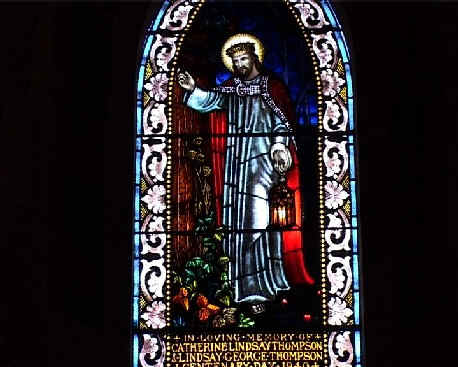 To become a Freemason, you must be a seeker - a seeker of Knowledge.
To become a Freemason you must knock at the Door to discover the mysteries of the Temple of Light.
Jesus shows you the way to knock at the door to receive the light he is carrying in his hand.
Taken from a Mosaic Window - The Garrison Church, The Rocks, Sydney, Australia
To become a Freemason, you must be a seeker - a seeker of Knowledge.
To become a Freemason you must knock at the Door to discover the mysteries of the Temple of Light.
Jesus shows you the way to knock at the door to receive the light he is carrying in his hand.
Taken from a Mosaic Window - The Garrison Church, The Rocks, Sydney, Australia
The Gnostics had many levels of initiation, and the mysteries of these different grades were not written down like the more esoteric surviving texts were, but were given verbally at special ceremonies. Elements like the recipe of the obviously psychoactive holy oil were guarded with the closest secrecy, and were known only by the sect's most trusted initiates. This was a standard mystery school method, as "magic revealed is magic lost", and such secrets could only be entrusted to the group's most loyal members.
"Gnostic treatises did not reveal the whole matter. . .
the final revelation was only communicated by word of mouth in
the body, and by vision out of the body."
"It is certain that Gnostic texts even in cultic matters favour
a metaphorical symbolic manner of speaking and. . . clearly avoided
communicating precise details about their 'mysteries'.
The term Gnostic, meaning "knowledge", refers to a variety of early Christian sects which had extremely different beliefs about both Jesus and his teachings than those which have come down to us through modern Christianity.
The kings of the early succession (who reigned in Sumer and Egypt before becoming Kings of Israel) were anointed upon coronation with the fat of the Dragon (the sacred crocodile). This noble beast was referred to in Egypt as the Messeh (from which derived the Hebrew verb 'to anoint'), and the kings of this dynastic succession were always referred to as 'Dragons', or 'Messiahs' (meaning 'Anointed Ones').
The Greek word gnosis means knowledge and especially, knowledge of God. This is quite different from knowledge about God found in theology and religious dogmas. It is also distinct from mere belief, or blind faith based on hearsay. Gnosis is both a quest for redeeming knowledge and a quest for one’s inner self.
Even the Church Fathers Clement of Alexandria (150-215 AD) and Origen (185-254 AD) admit that the followers of Jesus the Christ were Gnostics. Clement called the perfect Christian "the gnostic" and pointed out that the apostle Paul uses the term gnosis in his letters. Philo of Alexandria, a contemporary of Jesus, used the word gnosis in quoting biblical texts (Isaiah 11:9, Hosea 6:6, Job 35:16) and frequently applied it to a specifically mystical kind of knowledge. For the Israelites, "to know" meant "to experience".
Gnosis is not a religion among others, but is the heart of all authentic religions and the core of the messages brought by the Prophets of the Eternal One. Gnosis is a Path of pure worship based on knowledge combined with love, rather than fear.
There is much scholarly debate as to when Gnosticism began,
whether it is pre-christian or post-christian. Essene Nazoreans
see the origins of Gnosticism existing before the Christian era
within the ancient Palestinian sect of Nassaraeans mentioned by
Epiphanius. Echoes of this pre-Christian ethos can be discerned
within the older strata of modern Mandaean writings. (These
older gnostic teachings were transferred into Mandaean circles
via Zazai's codification about 272 A.D.)
..more on Gnostic teaching..
see The Gnostics
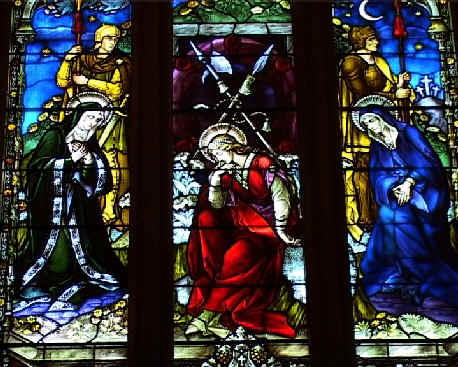 JESUS BEING RAISED
The Tomb of Jesus shows the doorway being guarded by two Sentries The
Wands crossed between the Square (the Doorway) joined by the Cable
Tow - The Mystic Tie, bound between the Circle of Knowledge shows
Jesus kneeling taking his obligation.
JESUS BEING RAISED
The Tomb of Jesus shows the doorway being guarded by two Sentries The
Wands crossed between the Square (the Doorway) joined by the Cable
Tow - The Mystic Tie, bound between the Circle of Knowledge shows
Jesus kneeling taking his obligation.
Being a Gnostic Christian or Nazarene meant discovering
one’s spiritual nature, discovering, as one teacher put it:
Who we are, and what we have become; where we were and where
we have been cast; toward what end we hasten and whence we are
redeemed; what is birth and what is regeneration.
The reader will immediately notice that we are on the same territory Tertullian deemed the breeding ground of "heretics". These very questions always infuriate and challenge the purveyors of so-called ‘orthodoxy’.
By the fourth century, in the time of the Emperor
Constantine, the Gnostic Nazarene communities had been
suppressed and the few authentic teachers were either
exterminated or driven underground. Thanks to the power of
the State, Roman Catholicism was now the undisputed ‘orthodox’
Christian Church. From this Roman Church later came the various
protestant sects.
More about this on
The Lies of Paul
Despite continued persecution, the message of the Gnostics survived. Their teachings forming the basis of what became known as the Secret Tradition. A wisdom only termed ‘secret’ because concealment was often used to preserve it in purity from the tyranny of the official Church and State.
Cosmic Battle: An Introduction to the Beginning and the End draws extensively on the Gnostic scriptures and the writings of the Essenes. Presenting concepts long suppressed or distorted by the world order. Our take on the False Church of Rome
According to this writer, The Path of "Aumenite Gnostics" was restored to the earth on January 25, 1981 under the auspice of Sons Aumen Israel. (Sons Aumen being a direct translation of the Hebrew "B'nei Aumen", and Israel being a translation of the Mandaean "Yaqif", or Jacob, signifiying the non monastic membership gathered around the B'nei Aumen Temple complex.) This Path seeks to understand and encorporate the many wondrous teachings of the Valentianian Branch of Gnostic Christianity.
Another writer says, The ministry of Jesus marked the return of the Jewish Messiah-kings, and thus the re-emergence of a holy oil. They say Jesus was called the Christ because he violated the Old Testament taboo on cannabis oil and distributed it freely for initiation rites and to heal the sick and wounded.
The title "Messiah" is much older than Christianity, as all the ancient kings of Israel are referred to as the "Messiah". "Christos - Anointed One, a title of many Middle-Eastern sacrificial gods: Attis, Adonis, Tammuz, Osiris. Christinaity picked it up and claimed priority rights to the word and it's meaning and claimed all other meanings as mentioned above, to be pagan.
To the Jews, 'Messiah' was a term which meant a person who will become the rightful King of The Jews'..The man we call Jesus never achieved this, therefore the Hebrews did not believe him to be the true Messiah. In order for Jesus to be the true Messiah, to the Hebrews, he would have had to lead a war against the Romans and run them out of the country, thus saving the people. This may be why most Christians dislike Jews and say the Jews didn't believe Jesus was the true messiah. This is confirmed by some of the letters of Josephus...and Jesus said his own people would not believe in him. However there was a war going on and a 'split' amoung the priests had occured, which formed another religion seperate and different from the teachings of Enoch and Moses.. As you can see by history's lessons, there is much that is not fully understood and therefore becomes misinterupted by many.
Frequent references to fish are intended as symbolic of The Christ, having nothing to do with the act of eating a dead fish. But the symbol of the fish did not meet with Roman approval. They preferred the sign of the cross, choosing to concentrate more on the falsely reported death of Christ at his crucifixion rather than on his brilliant life and healing works. Perhaps this is one reason why only ten percent of his life record appears in the canonical scriptures. Most of his first thirty years are omitted. His birthday, celebrated by billions, is even wrong!
Those holding the Essene theory must now argue that the term
'Essene' came to designate the originally Sadducean sectarians
who had gone through a process of radicalization until they
became a distinct sect. Gradually, over time, these original
Sadducean priests who had defected from the Temple began
to develop the mentality of those who are rejected and outcast.
Could it also be that over time they came to be known as Essenes?
Link to The Essene Nazarean Church..
The Essene Nazarean Church
of Mount Carmel
The Essene Nazarean Church of Mount Carmel is the congregation of the B'nai-Amen Temple Order, an esoteric spiritual Order, which fully embraces the deeper levels of the ancient Nazarite 'Way' of Yeshua Ha Mashiakh (Jesus the Messiah). "We are a modern resurrection of the ancient B'nai-Amen Temple Order of the Carmelite, Nazarean Essenes".
The Carpenter's Son?
John Dominic Crossan: Professor Emeritus of Religious
Studies DePaul University:
"The difficulty for us in hearing a term like carpenter is that
we immediately think of a highly skilled worker, and at least
in North America, in the middle class, making a very high
income. As soon as we take that into the ancient world we are totally lost.
Because first of all there was no middle class in the ancient
world. There were the haves and the have nots to put it very simply.
And in the anthropology of peasant societies, to say that somebody
is an artisan or a carpenter is not to compliment them."
L. Michael White:"He must be someone in the artisan class if he's working in the,
in the building industry. And in all probability that
would mean where he might grow up and live in Nazareth, he likely
went to Sepphoris to earn his living. And this puts him in
the interesting mix of cultures that would have been the
daily life of a city like Sepphoris, through the marketplace, in the building.
And Sepphoris itself as a city was built precisely at
the time that Jesus was growing up and living just next door."
But the term 'carpenter' actually meant 'craftsman' and is also the term commonly applied to Masonic and ancient Egyptian secret teachings. The professors of our time have not understood the 'coded' words Jesus and the disciples used when describing themselves and their ancient secret rights. However this also means Jesus wasn't poor and neither were the disciples. Their earnings went to the community to share for the benefit of all.
Jesus' father Joseph, has been misidentifed as a carpenter. The origional Greek text refers to him by the style of ho tekton derived from the Aramaic term naggar. This should have not been translated as 'carpenter', but as 'craftsman'. As pointed out by the Semitic scholar Dr. Geza Vermes, the descriptive word would more likely define a scholar or master. It certainly did not identify Joseph as a woodworker. More precisely, it defined him as a learned man with great skills in his occupation. In practice, after the Old Testament styles of Tubal-cain, Bezallel, and Hiram of Phoenicia, Joseph could well have been a master artificer in metals at the Qumran fire-stone refinery. Secrets of the Lost Ark
A central characteristic of the Gnostic Tradition, in all
its multifarious forms down through time, is total refusal to
compromise with a damned world contaminated by evil and the
devil. The Gnostics declare that all institutions, laws,
churches and systems are nothing but a sham and a trap, the
perpetuation of an age old deception. Consequently they were
hated and relentlessly persecuted by the powers-that-be. In the
words of Jacques Lacarriere:
The Gnostics saw themselves as rebels, misfits in a malign
system on a cosmic scale. And like rebels in society they felt
compelled to act provocatively, to express their inability to
submit and to attract others away from the system’s stranglehold.
They deliberately set about standing everything on its head,
inverting all standards, beliefs and preconceptions.
The Gospel of Thomas, a Gnostic text discovered at Nag
Hammadi, records Jesus as declaring:
Let him who seeks continue seeking
until he finds. When he finds,
he will become troubled. When he becomes troubled, he will be
astonished, and he will rule over the All.
Scholars now admit that while the four New Testament Gospels were written between 60 AD and 110 AD, the Gospel of Thomas contains material dating to 50100 AD. A 1995 joint meeting of the American Academy of Religion and the Society of Biblical Literature announced that the Gospel of Thomas should be a part of the New Testament.
The Essenes believed the attainment of knowledge was the
way to enlightenment, which in turn was the way to know God.
Gnosticism was the knowledge of God. The Gnostic teachings
arose from Zorastrianism, Judaism, oriental religions, Greek
philosophy, Persians, Hellenics and Early Christian teaching.
Jesus was a man of Great wisdom and knowledge and could do things
no one else, no other mortal man could do. He understood the principals of Al-chemy
and the Essenes/Gnostics knew of healing herbs and powerful
drugs to stop pain. The Aquarian Gospel of Jesus The Christ,
and The Apostolic Gnosis clearly explain the Bible and Jesus'
life from an inner/interior level of awareness...And points to
the Christ within as the redeeming element inherent within all
of humanity, and within all life everywhere... God (The Universal
Life Force) is omni-present...
His 'knowledge was Great' before the
Spirit entered him.
FACT; The disciples had all been 'raised from the dead, in the
initiatory process and they were all taught the 'secrets' and the
'Wisdom of God', that are continually mentioned in the New Testament.
These practices were not understood by the common people and not
taught to them. Through the practice of Yoga one can put hisself
or herself in a trance like state like Edgar Cayce did, and they can
travel out of their body. This is also called 'an out of body experience'.
This concept and practice begins with the Egyptians as they
ASCENDED to be the new Osiris. At the same time the new Horus
ascends and returns to the mortal 'material' earth as Enoch did.
Each time a Horus ascends, he becomes a 'son', understanding his
connection to God and doing God's will.
This practice and the 'secret knowledge' to attain it was lost when Seqenenre Tao was murdered. Moses and Jesus brought it back but the populace could not comprehend it, weren't privledged to know it and most people who did hear about it, 'threw it out' of known practiced religion.
Egyptian history on ancient religion teaches that this is done only by knowing and prounouncing correctly the names of the Gods. Only the High Priest and the King ( the Horus ) knew these names. The Egyptian Book of the Dead specifically forbids the information in the ancient rituals to be passed on to anyone other than a father or son, ( Rubic; the Four Torches )and they are the mysteries of the Tuat, ( Brotherhood ) written by Thoth, and shall be kept secret. The ritual is preformed only in the Tuat-Chamber and "they are symbolic of the things which are done in Khert-Neter" ( Heaven )..
More about the Essenes Based on:
"The
Teachings Of the Essenes From Enoch To the Dead Sea Scrolls"
by Edmond Bordeaux Szekely
" They also viewed man as having
3 bodies, not separate, but existing together in harmony, these
3 were recognized as the "acting", "feeling", and "thinking"
bodies. The greatest power of man's "thinking body" was wisdom,
and that of the "feeling body" was love,thusly, it was the
acting body's job to transform the wisdom and love into
actions in one's individual, social, cultural, natural, and cosmic roles.
The Parables
These two verses simply point out that the parables were cryptic and needed to be interpreted but those within the circle had been taught how to do it. This is purely Essene.
Mark gives the whole of chapter 4 largely to the significance of parables and to Jesus’s parables of the kingdom, intended to encourage his band.
Mark is convinced that parables are meant to obscure not to clarify but this has been generally ignored by theologians who give long explanations why the parables are actually not obscure. In the rabbinic tradition parables are used to clarify, yet the clergy are not averse to claiming this proves that Jesus, though supposedly repudiating the rabbinic tradition, used them in the same way. All of this fails to look at the question from Mark’s own conviction that they were intended to obscure, the reason being that Jesus was in the Essene tradition not the Pharisaic. Since the evangelist is quite explicit that the parables are allegorical-Jesus is saying so in Mark 4:13:
"And he said unto them, Know ye not this parable? and how then will ye know all parables?"
Essenes considered that truth was obscure, drawing on the passage in Isaiah 6:9-12 where the prophet was commanded by God to tell the people:
Hear ye indeed, but understand not; and see ye indeed, but perceive not. Make the heart of this people fat, and make their ears heavy, and shut their eyes; lest they see with their eyes, and hear with their ears, and understand with their heart, and convert, and be healed.
Note the final expression "convert and be healed" in which healing is equated with conversion. The Essenes took this to mean that people were blind, deaf and hard of heart because they were unrighteous and would not take the trouble to learn the mysteries which God had given them in the scriptures. Taking this literally, they accepted nothing at face value and sought the hidden meaning in the scriptures. Only God’s righteous took the trouble to do this and it was against God’s will for them to bandy their discoveries about, so they kept them to themselves, in turn couching their own truths in an allegorical language which could be understood by other Essenes but not by anyone else.
If you check out Numbers 6: 1, you find Moses giving instructions; "When a man or a woman takes the special vow of a Nazirite, consecrating himself to the Lord in a special way,...." This proves there was a special sect that may not have been Jewish but seperate and reserved for those chosen to fulfill God's priesthood. Numbers 7: 6 - 16 confirms the priesthood duties and obligations. and... " For, lo, thou shalt conceive and bear a son, and no razor shall come on his head, for the child shall be a Nazarite unto God from the womb", from Judges 13:2-6, referring to the birth of Samson, who would have also been a student of this sect also.
In Mark 3.23, the evangelist told us that Jesus spoke in parables, further proof that Jesus was an Essene. For the Nazarenes he was the Master, the Maskil, whose duty was to impart knowledge with discretion and keep it secret from the wicked. We can conclude from this that the parables were allegorical and not, as theologians stoutly maintain, simple stories. If you still do not believe it read Matthew 13:14-15 where Jesus uses the above quotation from Isaiah to explain why he was teaching in parables.
In the Community Rule, the Master chants in his song of blessings to God:
My eyes have gazed on that which is everlasting, on wisdom concealed from men, on knowledge and wise design hidden from the sons of men.
The poem goes on to say that God has given these secrets to His elect as an everlasting possession. The Damascus Rule has similar phrases:
With the remnant which held fast to the commandments of God, He made his covenant with Israel forever, revealing to them the hidden things in which all Israel had gone astray.
In Isaiah 48:6 is God’s promise to reveal hidden things (nasar), yet another hint to the word Nazarene-a revealer of hidden things. It was the duty of the Master to instruct the sectaries in these mysteries of amazing truth, that they may walk perfectly together in all that has been revealed to them. Nevertheless, earlier in his song the Master promises: I will impart knowledge with discretion. Thus, though the Community Rule prescribes that all novitiates will be taught the things hidden from Israel without fear that he will become an apostate (and reveal them elsewhere), for the men of deceit, the Master was obliged to maintain a spirit of secrecy and to conceal from them the knowledge of the truth and righteous judgement that was required for a proper understanding of the law and the prophets.
The first parable is that of the sower much of whose seed goes to waste. It is an allegory, a coded story, which is explained to the twelve-Mark’s way of showing that the disciples had to be taught how to understand them. He tells us that the parables are allegories by deciphering this one. The reader realizes that the parables were meant to be obscure but because this one does not seem particularly so, it serves the aim of the followers of Paul, who had gained hold of the church, to denigrate as idiots the original followers of Jesus. The deciphering is bogus because it is done to suit the Christian church and not to interpret the original parable, so the changes in some instances are very great and misleading.
Essenes regarded scripture as mysterious. The use of the phrase, mystery of the kingdom of God, emphasizes the link between the gospel and the Essene scrolls. Paul often uses the word mystery (sometimes translated as secret) in his epistles. The Essenes used the pesher method whereby old documents were interpreted as prophetic of current events. The Habakkuk Commentary of the Dead Sea Scrolls is of this type. The Essene sages sought to read in the scriptures the hidden things of God and, having discovered them, they sought to conceal them from unrighteous ears. This is the real significance of the parables of Jesus. They look like simple moralistic folk tales but there is more to them than meets the eye... or ear! Those that had ears to hear, those who had been taught and had grasped the method, would understand references intended to baffle the ignorant.
When Jesus says them that are without he means those outside the company of the elect who could not understand the method and he gives a scriptural reference to the passage in Isaiah quoted above (Isa 6:10) by way of explanation. Specifically though he meant the foreigners present in the crowd who might understand Aramaic but would not be able to understand Jesus’s hidden messages-though they would be transparent to an Essene-and would not be saved if they did.
Hear now, all you who enter the covenant, and I will unstop your ears concerning the ways of the wicked;
Hear now, my sons, and I will uncover your eyes that you may see and understand the ways of God.
Deafness and blindness were Essene ways of describing lack of understanding-and Jesus used the same language. The author of one fragment of the Essene scrolls of Qumran admits he is writing in parables so that only a wise man would understand the deep mysteries that lay behind them. Elsewhere we get expressions like:
.."Give ear to me... those who pursue righteousness: you will understand my words and be seekers after faith and the hidden things of the testimony".....more? see Parables of the Kingdom of God
On the Pyramid page we are introduced to a 'secret room' in the Great Pyramid, said to hold the lost wisdom of the Atlantians . In this room there is described a machine which is a holographically operated mirror. This 'machine' was found by an explorer who ventured inside a secret burial vault under the paw of the great Sphinx. Osiris found this is an automatic scroll down once the page loads.
They also practiced Yoga and other forms of the higher thought
process. Astronomy required no telescope as it dealt, not
with the stars in the sky, but with the science of metaphysics
and the understanding of the forces determining the destiny of
individuals, nations, and the race Candidates were graded
according to their moral efficiency, and their spiritual or intellectual stature.
For years they underwent disciplinary intellectual
exercises and bodily asceticism; appropriate tests and ordeals
determined their fitness to proceed in the upper stages of their
initiation. Only the qualified candidates could proceed to learn
the closely guarded secrets. see the excerpts from the Dead Sea Scrolls,
Book of Community Rule .
Masonic Rules in the Dead Sea Scrolls
The last of the Essene stragglers buried the story of the
'Enochian Tradition'( The secret book in cave IV at
Qumran c.70 CE. ) The urban Christians and Jews of the Near
East rejected it. The authors of the Apocalypse rewrote and
retitled it, but they didn't understand the heptadic structure
of the origional lines, the arrangement of sevens. ( they said,"
The Revelation of St. John is pure gibberish, a sloppy rehash
of Babylonian myths and legends.") Only the student
of the Merkabah ( in Babylonia ) possessed the key to the
Enochian mystery."
Brian, "ENOCH ,
The Greatest Story Never Told"...
In 130-200AD, the Catholic Church Father Irenaeus accused the Gnostics of initiating members with "secret sacraments". In his discussion of Gnostic texts which dealt with the anointing rite, he stated that they were written in an archaic manner, "to baffle even more those who are being initiated."
We can add to Ireneaus's comments that the Gnostics likely wrote in such a concealing fashion to "baffle" their persecutors, like Ireneus, whom they feared would find out the source behind the secret power of their anointing oil.
26-36?: Jesus the Nazarene: - French: Jesus le Nazareen - Medieval Latin:Jesus Nazarenus - Latin:IESVS NAZARENVS - Greek:Iesous ho Nazarenos (or Nazoraios) - Aramaic: Yeshu haNatseraya - Hebrew Talmud:Yeshu haNotseri - Hebrew Bible: Yeshua'- Yehoshua'; son of Mary, born 12-4 bce?
Citing the prophet Isaiah, the angel informs Joseph that this child will be the fulfillment of the prophecy of "the virgin bearing a son, and calling His name 'Immanuel,' meaning 'God with us'" (Isa. 7:14).
The Old Testament refers indirectly to Mary in those prophecies which predict the incarnation of the 'Word' of God.
The argument is based on the premises that the prophet's virgin is the mother of Emmanuel, and that Emmanuel is Christ. The prophecy predicted also Mary's virginity untarnished by the conception of the Emmanuel.
"the stretching out of his wings shall fill the breadth of thy land, O Emmanuel". In 9:6, the government of the house of David is said to be upon his shoulders, and he is described as being endowed with more than human qualities: "the prophet calls Emmanuel "a rod out of the root of Jesse" endowed with "the spirit of the Lord. . .the spirit of wisdom and of understanding, the spirit of counsel, and of fortitude, the spirit of knowledge and of godliness"; his advent shall be followed by the general signs of the Messianic era, and the remnant of the chosen people shall be again the people of God (11:1-16).
The KABBALAH
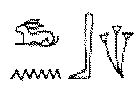 Kabbalah, Qabalah or Cabala. It comes
from the Hebrew word QBL meaning "oral tradition".
An esoteric and mystical division of Judaism. What the
Kabbalah does is present a symbolic explanation of the origins of the universe.
It shows the relationship of humans to the God with the approach
to creation where the Infinate Light manifests through different Sephiroth
of the Tree of Life.
Kabbalah, Qabalah or Cabala. It comes
from the Hebrew word QBL meaning "oral tradition".
An esoteric and mystical division of Judaism. What the
Kabbalah does is present a symbolic explanation of the origins of the universe.
It shows the relationship of humans to the God with the approach
to creation where the Infinate Light manifests through different Sephiroth
of the Tree of Life.
The Kabbalah has strong links with Gnosticism.
This is a Hieroglyph of the three sacred lotus lilies meaning "Tree of Life". It was
the trunk of the Tree of Life which represented
the World Pillar or Axis Munde (literally "Axis of the Mound")
around which the heavens appeared
to revolve. The World Pillar was the centre of the universe. It was Osiris as the Djed
Pillar, the Pillar of Stability and it was the Great Pyramid of
Egypt.
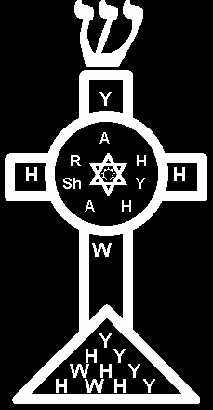 All the truely
dogmatic religions have issued from the
Kabbalah and return to it: everything scientific and grand in
the religious dreams of the Illuminati, Jacob Boehme,
Swedenborg, Saint-Martin, and others, is borrowed from Kabbalah,
all the Masonic associations owe to it their secrets and their
symbols.
All the truely
dogmatic religions have issued from the
Kabbalah and return to it: everything scientific and grand in
the religious dreams of the Illuminati, Jacob Boehme,
Swedenborg, Saint-Martin, and others, is borrowed from Kabbalah,
all the Masonic associations owe to it their secrets and their
symbols.
Masonry, like all the Religions, all the Mysteries,
Hermeticism and Alchemy, conceals its secrets from all except
the Adepts and Sages, or the Elect, and uses false explanations
and misinterpretations of its symbols to mislead those who
deserve only to be misled, to conceal the truth, which it calls
Light, from them, and to draw them away from it. Truth is not
for those who are unworthy or unable to receive it, or would
pervert it.
Brother Albert Pike
Morals and Dogma, page 104
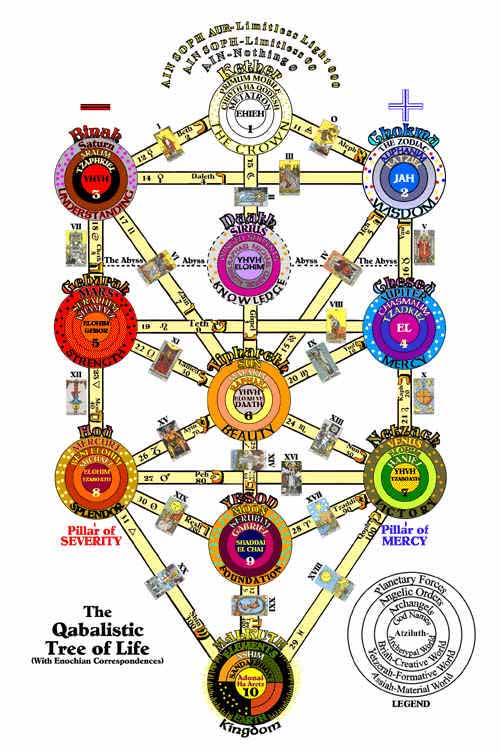 The "tree of Life; The centers are arranged in three
columns. The left column is called the Pillar of Severity.
The "tree of Life; The centers are arranged in three
columns. The left column is called the Pillar of Severity.
This represents the female side of man and contains three sephira: Binah (Understanding), Geburah (Severity) and Hod (Splendor).
The right column is called the Pillar of Mercy.
This represents the male side of man and also contains three sephira: Chokmah (Wisdom), Chesed (Mercy) and Netzach (Victory).The middle pillar is called the Pillar of Equilibrium. It represents the balance between the male and female pillars. It contains four sephira: Kether (Crown), Tiphareth (Beauty), Yesod (Foundation) and Malkuth (Kingdom).
The Kabbala requires four of these Trees, one for each world of the cosmos. The connections; Winged Discs, Omphalos, Arcs & Archetypes - The ark of the Covenant, Isis - Greek - Egyptian art. more..Tree of Life Kabala
In the early days it was passed down by word of mouth. In around 1280 it was written down most likely by Moses de Leon. All manifestations are said to have their origins in Ain Soph Aur. The system is monotheistic in nature but yet allows for a tenfold structure of the Sephiroth upon the Tree of Life.
The Zohar reveals the exact year the Messiah will return and a prophesy that the city of Rome will be destroyed. It declares that a great leader will rise and conquer the world, probably out of Syria. A war against Isreal will transpire, but the chosen people will prevail. The King Messiah will come, the city of Jerusalem will be rebuilt and then the Messiah will bring about the union of heaven and earth. There will be ONE LAW and ONE World religion, that which has seen the 'light'.
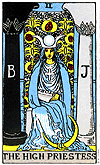 The renowned Hermetic Order of the Golden Dawn used the
Kabbalistic Tree of Life. It has also become popular to
link the ten Sephiroth of the Tree of Life with the tarot cards
of the Major Arcana. This is where the Templers came in. Mary
Magdalene was the highpriestess.
The renowned Hermetic Order of the Golden Dawn used the
Kabbalistic Tree of Life. It has also become popular to
link the ten Sephiroth of the Tree of Life with the tarot cards
of the Major Arcana. This is where the Templers came in. Mary
Magdalene was the highpriestess.
The Four Worlds:
Atziluth:
Representing the archetypal world, pure Divinity, and Yod of the
Hebrew Name of God. It corresponds to the Suit of Wands in the Tarot.
Briah:
Representing the creative world, the Archangelic, and thee in the
Hebrew Name of God. It corresponds to the Suit of Cups.
Yetzirah:
Represents the formative world, the Angelic, and Vau is the
Hebrew name of God. It corresponds to the Suit of Swords.
Assiah: Representing the material world, man, and the final
He in the Hebrew Name of God.
It corresponds to the Suit of Coins.
Notice the J and the B on the pillars.
The Templers designed these cards as a means of secret language after the Church
banned their activities and had the Templers executed and burned at the stake.
The Church then Banned the Cards, saying they were evil too.
The Templars and the Tarot
and this one..
The unveiling of the Royal Secret The Zodiac and the
Tarot
Another important figure is Nostradamus
On December 14, 1503 in St. Remi, France, Michel de Nostredame was born. The first son of Jewish parents, forced by the Inquisition to convert to Catholicism, would become a skilled physician but would gain renown during his lifetime and beyond as a seer of the future.
In 1522, at the age of nineteen, Nostradamus decided to study medicine and enrolled at Mont Pellier (the most famous school of medicine in France). It was at this time Nostradamus is believed to have been reintroduced to mystical and ancient books of knowledge.
Growing up he spent much of his time learning languages, math, astronomy, and astrology from his grandfather, Jean. Later he attended the University at Avignon where he studied liberal arts. Afterwards, he graduated from the medical school at the University of Montpellier and began a private practice where he succeeded at treating plague victims in Montpellier and the surrounding areas.
Sadly, both Nostradamus' wife and their two children were struck by disease and died. As if to add insult to injury, in 1538 Nostradamus was falsely accused of heresy by Church officials, due to an innocent comment he made one day about a church statue. This was unjust because Nostradamus was a spiritual and religious man.
Nostradamus has become one of the world's most widely known and read prophets.
In 1555, at the age of 52, he wrote his first collection of Centuries - a set of 100 quatrains. Over the next several years he would complete a total of 10 Centuries.
A quatrain is simply a poem with 4 lines.
The rhymed quatrains of Nostradamus were written mainly in French with a bit of Italian, Greek, and Latin thrown in. He intentionally obscured the quatrains through the use of symbolism and metaphor, as well as by making changes to proper names by swapping, adding or removing letters. The obscuration is claimed to have been done to avoid his being tried as a magician. Of course a skeptic might say it was done so the quatrains could be interpreted to fit numerous situations.
In 1564 Nostradamus was appointed Royal Physician to King Charles IX.
Some historians suggest that Nostradamus was a descendent of the lost Jewish tribe of Issacher, a tribe that was noted to be knowledgeable in astrology and the mystical arts. As a child, Nostradamus was apparently influenced by occult Jewish literature.
On July 1, 1566 Nostradamus offered his final prediction to his priest. In response to the priest's farewell of "Until tomorrow," Nostradamus is said to have answered: "You will not find me alive at sunrise."
Nostradamus died that night.
His poetic yet cryptic quatrains are claimed by some to conceal information about future events. He completed a total of 942 quatrains which he organized into Centuries - groups of 100 quatrains (one Century only had 42 quatrains).
Do these writings actually predict the death of popes, rise of tyrants, and natural catastrophes to come? see Nostradamus
Apparently, various nations who embrace Christianity will be military targets of the third antichrist. Nostradamus clearly states in his Epistle that the followers of Christianity will face a horrific persecution in the future. In his Epistle, Nostradamus stated that at some point in the future, global flooding will occur. No specific date is mentioned regarding its occurrence, except that it will happen sometime "after" the fall of the future third antichrist. see The Future
These perscripts are important for two reasons. First they indicate that the Catholic church was hiding something remarkable. Secondly, the church would kill or jail those who went against their doctrines. Those living in 'church controlled areas' often joined the church, adhered to it's strict rules just too keep from being prosecuted. This doesn't mean they agreed with them. We have seen two important references to, 'occult Jewish literature' and 'conflicting New Testament material'. These references have occured numberous times throughout our so-called religious history. There must be a reason.
![]()
The Dead Sea Scrolls
Of the seven leather-bound codexes or books found in Egypt, containing 49 tractates or writings, the dating of which varies in opinion from the 1st to the 4th century, Dr. Northup said only five of the writings have been generally published so far, most of it abstract material.
Of the Dead Sea scrolls, dated between 200 B.C. and 70 A.D., four volumes have been published so far, with six others still to be issued, which is expected within the next four years.
Besides detailed records about a separatist Jewish community, the Essenes, which lived in isolation beside the Dead Sea through Jesus' time, the documents also include all or parts of every Old Testament book except Esther, providing copies 1,000 years older than available before.
"We now have a much more complete picture of the conditions both at the time Jesus lived and in the early period afterward," Dr. Northup said. "But the material also raises new questions and possibilities." Among those questions, he noted, is whether the immediate forerunner of Jesus, John the Baptist, or even Jesus himself, were at some point associated with the Qumron community, the Essenes, who left the scrolls. But if they ever were related to the group, they broke with it and differed decisively in their teachings, he said. He noted that while both Jesus and the Qumron community pointed to the Old Testament Scripture, the community only interpreted it to justify its own views, while Jesus made his own personal authority central, asserting an advance in revealed truth.
"He didn't use Scripture to justify his authority, but claimed it within himself, saying the way people acted toward him was the decisive thing," Dr. Northup said. However, he noted that Jesus, in his sharp criticisms of various religious parties and sects in his day, never mentioned the Essenes, possibly "because, even though differing from them, he may have felt they were searching similar points of faith."
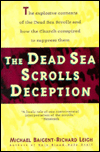 Publisher's Weekly
Publisher's Weekly
For the lay reader, this crystalline, well-documented work offers substantive evidence that for more than 40 years a small coterie of Catholic scholars established a stranglehold on access to the Dead Sea Scrolls, which were discovered in the Qumran caves east of Jerusalem in 1947. Baigent and Leigh ( Holy Blood, Holy Grail ) claim that the elite group had direct links to official Vatican propaganda offices, that at least two among them were outspoken anti-Semites, and that they suppressed material that connects early Christianity to the Qumran community as well as to the zealous defenders of the fortress of Masada. Drawing on the findings of independent Dead Sea Scrolls scholar Robert Eisenman of California State University, the authors advance startling theories that should change the way we view ancient Judaism and nascent Christianity. They argue that the Essenes, Zealots and Nazorenes or early Christians in first-century Palestine weren't different Jewish sects but were, rather, various sobriquets for members of a broad messianic nationalistic movement dedicated to upholding the Law of Moses and determined to violently overthrow the Roman occupiers.
The authors also amass evidence that the Habakkuk
Commentary and other Dead Sea Scrolls refer to the same events
as those recounted in Acts, in Josephus and in the works of
early Christian historians; that Paul was sent forth by the
hierarchy in Jerusalem for the express purpose of recruiting
an army, and by preaching a new religion, he was depoliticizing
and emasculating the militant movement; and that Paul might
have been a Roman agent or informer.
Baigent and Leigh
demonstrate the perfidies of clandestine, cliquish scholarship.
(Cliquish; A narrow exclusive circle or group of persons,
one held together by a presumed identity of interest)
But Jesus belonged to such a group.
We have seen this proof elsewhere as with schollers such as Ogden, G.R.S. Mead, Philo, Kersten, Origen and others. Robert Eisenman, chairman of the Department of Religious studies of the Califorinia State University was able to obtain photographs of the scrolls. From his review came the same conclusion. Paul was indeed a Roman operative much like our C.I.A. of today. Paid to infiltrate the Essene community and get as much information as he could. Enough to bring down the freedom fighters at their very core.
François Rabelais
The life of this celebrated French writer is full of obscurities.
He was born at Chinon in Touraine in 1483, 1490. or 1495.
According to some his father was an apothecary, according to
others a publican or inn-keeper. He began his studies with the
Benedictines and finished them with the Franciscans near Angers.
He became a Franciscan in the convent of Gontenay-le-Comte, where
he remained fifteen years and received Holy orders.
But the spirit of his order not being favourable to the studies then esteemed by the Renaissance and for which he himself displayed great aptitude, he left the convent. Through the mediation of Bishop Geoffroy d'Estissac he secured pardon from Clement VII, who authorized him to enter the Benedictine abbey of Maillezais. In 1530 he was at Montpellier as a medical student, and the following year professor of anatomy at Lyons and head physician at the hospital of Pont-du-Rhône.
In 1534 Cardinal du Bellay brought him to Rome as a physician, and in 1536 he obtained from Paul III an indult which absolved him from his infractions of conventual discipline and allowed him to practice medicine. The next year he received the degree of Doctor of Medicine at Montpellier. In 1540 the pope permitted him to abandon the conventual life and to join the canons of St-Maur-les-Fossés. He took advantage of this to resume his wandering life. In 1541 he was at Turin as physician to the governor, Guilliaume du Bellay. Perhaps through fear of persecution which his works might draw upon him he went in 1546 to practice medicine at Metz, where he was in the pay of the city, but Cardinal du Bellay, being again sent to Rome, induced him to go thither.
Some years before he wrote his book, Rabelais was temporarily imprisoned in his monastery, when he and another brother started studying Greek works. At that time the Greek language was considered heretical because conflicting New Testament material written by patriarchs of the Byzantine Christian Church was written in Greek and opened up the possibility of criticism of the Roman Catholic Church. Also, so-called Pagan and Gnostic texts were written in Greek. It is not clear what the nature of the information in the original Greek text was, but from what history has recorded, the church leaders must have felt threatened by it. Rabelais managed to obtain an indult (special exemption) from Pope Clement VII and went on to write his famous Works. Unfortunately little is known of Rabelais after his books were published. He virtually disappeared in the midst of outrage from church and state over their publication.
According to some he died as a free-thinker and jester, saying, "Draw the curtain, the farce is played out", according to others his end was Christian and edifying.
In an attempt to save their manuscripts from the editorial flames of the Roman Catholic Church, certain Christians, now considered Gnostic heretics, hid copies of their scrolls in caves. One of these ancient hiding places was rediscovered in our own century, and the large collection of early Christian documents was named the Nag Hamadi Library, after the Egyptian area where it was found. Prior to this discovery, what little was known of the Gnostics came from a few fragmentary texts, and the many polemics written against them by the founders of the Catholic Church.
Continued on Kaballah, part 2
Search this site
Our search Engine does not search for the links in this site, only words in the text.
NO PART OF THIS SITE MAY BE COPIED OR REPRODUCED, IN WHOLE OR
IN PART WITHOUT THE EXPRESS WRITTEN APPROVAL
OF THE WEBMASTER...© COPYRIGHT 1999 - 2009 C.I.C. All Rights Reserved
This page has been visited.. Times since December 14th, 1999.